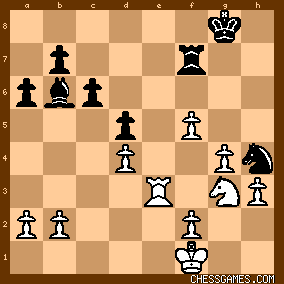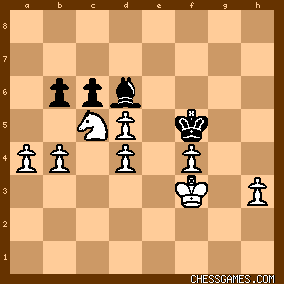| KEG: As whatthefat has noted, this was a crucial game in the London 1899 tournament--perhaps the turning point--since Janowski had been ripping up the field for his first eight games and Lasker with this win went on a tear and blew away the field for the rest of the Tournament. I also agree with AmEnglishman that this was a "tough hard struggle for both sides" and a "pretty ragged game." Lot of excitement here, and lots of incredible errors, most of which are ignored in the commentary in the Tournament Book. Lasker's decision on move 13 to sacrifice his Bishop for three pawns may not have been the theoretically best choice, but it led to a position that was uncomfortable for Janowski, and the game after 17 moves yielded about equal chances for both sides: 
click for larger viewFrom here on, the play indeed became "ragged." Lasker should have played 18. f5 (instead of his useless 18. Ng5). As noted by others here, Janowski could have played 18...Qh8. But Janowski--apparently fearing Lasker's endgame prowess, repeatedly bypassed chances to trade pieces. His 18...Nf8, though not as strong as 18...Qh8, left him safe and with a small edge. But he missed another chance to trade pieces and end Lasker's attack when he played 23...Qd6 (instead of 23...Qd7 or 23...Qc8). When Lasker tried 24. g4 (24. Qh5 was theoretically best, but Lasker knew his opponent), Janowski again could have played 24...Qd7. Instead, pieces were exchanged only when it suited Lasker. After move 40, following the exchange of Queens, and contrary to the suggestion on the Tournament Book, the chances were even: 
click for larger viewBut from here on Janowski's play was dreadful. After the exchange of Rooks on move 44, Janowski went to pieces. His 46...Bb6 turned an even ending into a big plus for Lasker (46...Kf6 was better), and his 47...Kf6 [one move too late!) was a blunder (he had to try 47...a5), and Lasker suddenly had the game in hand After further poor moves by Janowski in what was already a lost position (51...b6 instead of 51...Bxf4; 53...Ke6 instead of 51...Bxf4; and 54...Kf5 instead of 54...Be7). The game was---or should have been--over. Lasker was up two pawns in a Knight against Bishop ending with monster threats on both sides of the board. Time to resign for Janowski? But then, rather than taking the simple win available to him with 55. a5, Lasker decided to sacrifice his Knight with 55. Nc5. The Tournament Book things this was a cleaver way to close out the game. Really? Here was the position after 55. Nc5: 
click for larger viewJanowski here played 55...Bxf4, and resigned one move later. The Tournament Book states that Lasker had an easy win after 55...b6xN 56. d4xc5. But after 56...Bxf4 57. a5 Bb8, the win is anything but obvious to me. After a 26-ply search, Fritz rates the position as (1.75). A win for Lasker? Probably, but there was lots of play left in the game. Had Lasker played 55. a5, Fritz rates the position (6.58). Even though 55. Nc5 probably kept Lasker's win intact, why go in for all of this when 55. a5 was such a simple win? Even after Janowski declined Lasker's Knight sacrifice with 55...Bxf4, Lasker seemingly erred again. Instead of the immediately decisive 56. Nb7, Lasker played the far less effective 56. Nd7...and Janowski resigned! Fear was undoubtedly a key factor in this game. Janowski feared endgames with Lasker, and failed to put up strong resistance once an endgame was reached. Like Fischer-fear decades later, Lasker-fear was a powerful element in his success. | 




